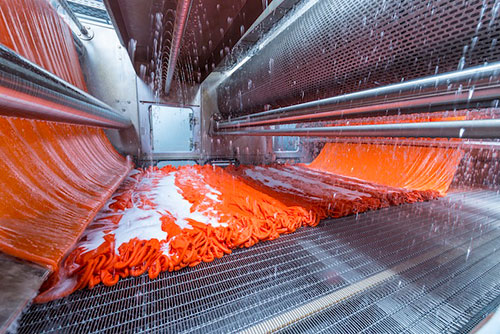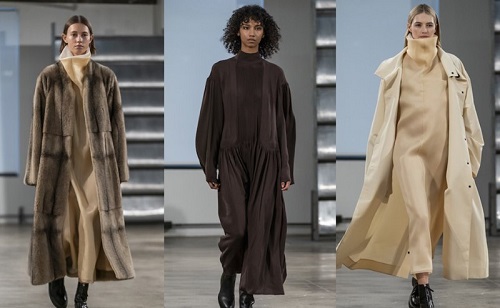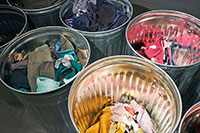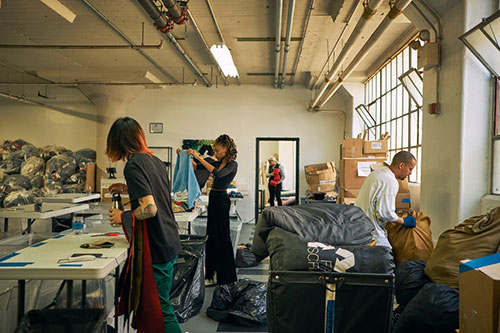FW
Bangladesh Garment Manufacturers and Exporters Association (BGMEA) gave a presentation at a discussion on ‘RMG Industry: Green Growth’. Representatives from the International Labour Organisation, International Finance cooperation, buyers, economists and government officials attended the discussion. It was highlighted that global brands and buyers are gradually offering lower prices for readymade garment products to Bangladeshi factories although the number of green factories has increased considerably in the country in the last few years.
BGMEA president Rubana Huq said although buyers were not giving additional prices for products, the entrepreneurs were investing additional money to make their units green to create sustainable businesses. She also said government policy and incentive, buyers’ demand, consumer behaviour and availability of technology are the key factors that can enable the industry to become green.
Speakers emphasised on the development of a national standard for green industry and adoption of a comprehensive policy to support the industry. They also said that adoption of green technology was a must for sustainable economic growth and Bangladesh needs home-grown solutions to face the challenges faced in building a green industry.
Speakers said that it was easy for large-scale factories to arrange green funds but medium- and small-scale factories were not getting access to finance. They suggested that the government and its development partners should introduce guarantee schemes for the SMEs so that they could go green.
Fulgar is the innovative, organic-origin DIN CERTCO certified yarn, has launched eco-friendly Q-NOVA Pure Black yarn developed in line with ‘advanced eco design criteria’. This new specialty yarn joins the highly successful Q-NOVA yarn and together,
Fulgar says, they have inspired the creation of a new family of yarns. Launched by Fulgar in 2013, Q-NOVA by Fulgar, 100% Made in Italy is a polyamide yarn made using regenerated raw materials through a mechanical, non-chemical process that renders the entire production cycle more sustainable, making it possible to achieve reductions in CO2 emissions and water consumption. This virtuous yarn is further enhanced in the version given stretch performance by combining it with the Lycra EcoMade recycled elastomer, which has also been awarded Global Recycled Standard certification for fabrics and garments that are ‘friends of the environment’.
The advantages include simplification of the dyeing process and the total absence of additional black dye with a resulting reduction in water use, energy consumption and waste, as well as total safety for the final consumer.”
Its ability to make the company’s production processes more sustainable means that Q-NOVA Pure Black has also gained numerous green certifications, including Global Recycled Standard. Fulgar says it uses PEF analytical methodology to measure its environmental impact.
Carvico gets into the future, in collaboration with Vizual, launches a new augmented reality costumer experience at ISPO 2020.
The Carvico world informs from its core, the logo the exclusive technology is now available to everyone from any device, Android and IOS, simply by framing the Carvico logo on any surface, be it a tag, a shopper or the website or social media.
Augmented reality thus becomes an effective tool to allow customers to access new digital content. On the occasion of the outdoor fair, the company tells the story of its sport-related soul: all it takes is a click to discover all that Carvico fabrics can do to support the best sports performance.
Euromonitor research, shares that the sportswear market in India has grown from INR 24,000 crore in 2014 to INR 37,000 crore in 2016 at more than 50 percent over the past two years.
Men's wear comprises the biggest share of the Indian sportswear market followed by the women's and kids' segments.
Improved comfort and performance has also led to the growth in sales of sports apparel.
The report points out that the Asia Pacific region is expected to be fastest growing region, with a CAGR of 6.9 percent over the forecast period. Sales came from emerging markets, such as India and Thailand, as well as the US, the world’s largest sportswear market.
According to reports from various internet sources, the Indian sportswear market grew 22 percent from 2015 to 2016, outpacing the segment’s global increase of 7 percent. A same study has shown a 23.7 percent CAGR for the 2011-16 periods with a forecast of 11.3 percent for the 2016-2021 periods.
Women’s wear is the fastest growing segment in the sportswear industry in India, now both for the industry and for the brands.
Earlier, it was highly underpenetrated, but now it’s a booming segment. While the men’s segment in sportswear is growing fast as numbers of sale, it is the women’s segment that is registering a higher growth percentage.
Swiss Textile Machinery members can reduce the adverse effect on environmental footprint of the finishing industry
 Since the antiquity humans have been exploiting color to enhance both the personal appearance and the world we live in. Dyed and printed textiles are a prime example, with a huge global coloration industry developing over the centuries. However, the massive consumption of water and energy required by many finishing processes, as well as the toxicity of some chemicals, has increasingly caused grave concern to environmentalists and the wider public. Conversely, responding to these worries has been the catalyst for innovation among eco-responsible companies in the Swiss Textile Machinery Association.
Since the antiquity humans have been exploiting color to enhance both the personal appearance and the world we live in. Dyed and printed textiles are a prime example, with a huge global coloration industry developing over the centuries. However, the massive consumption of water and energy required by many finishing processes, as well as the toxicity of some chemicals, has increasingly caused grave concern to environmentalists and the wider public. Conversely, responding to these worries has been the catalyst for innovation among eco-responsible companies in the Swiss Textile Machinery Association.
Green-tech denim dyeing
Washing processes, solvents and dyes in manufacturing account for one-fifth of industrial water pollution, according to the `State of Fashion 2020´ report by consulting firm McKinsey. This is the kind of evidence which sparks urgent calls to action addressed to politicians as well as textile brands. But the Swiss finishing machinery companies need no such wake-up call: for years, many of them have been actively developing and launching innovations with environmental friendliness as a prime requisite. An example is research into dyeing process which work without hazardous chemicals. At ITMA 2019, green technology denim dyeing became a reality with Smart-Indigo™, a Swiss innovation by Sedo Engineering, introduced at the show.
The underlying breakthrough was the ability to industrialize the electrochemical process for reducing indigo, using only electricity.
Ecological profitability no contradiction
The finishing industry today demands machinery which meets ecological requirements at the same time as enabling mills to operate profitably. That was the motivation behind the development of ESC (Energy-Saving Chamber) under the Santex brand of Santex Rimar Group. By re-using exhaust air from the Santashrink dryer, ESC increases production capacity by 15 to 17% from the same amount of heating energy. Maximum performance at low energy use, for low residual shrinkage, soft hand feel and surface luster is the goal of Santex machines. The specialized open-width fabric surface treatment systems always offer energy-saving options for sustainable production and low CO 2 values along with the promise of a return on investment in 1.5 years.
Two approaches to water savings
At Jakob Muller, top-quality technical parameters go hand-in-hand with the necessity for environmentally-friendly production in its innovative efforts. For example, its new washing module fulfils product and environmental needs, thanks to improved washing-off results with less energy and water consumption. It is important to the company that any dyeing processes use recycled water wherever possible. Open-width finishing equipment specialist Benninger tackles another important environmental issue in one of its latest developments by measuring pollution levels in the washing process. A sensor automatically gauges the level of pollutant, so that only the required amount of water is fed into the wash chamber, ensuring minimum use of both water and energy, and high reproducibility of the washing result.
Testing for sustainability
Producing laboratory and testing instruments, as well as customized production machinery, Mathis has a strong basis of expertise in the dyeing and coating sectors. The company understands the importance of quality assurance related to both performance and durability in applications such as sport and leisure.
 Often mistook to be a part of China, Taiwan is on a mission to establish its independent identity. Aiming to develop its industries independently, Taiwan’s Ministry of Culture has stepped up efforts to promote all domestic industries, including fashion. In October, the ministry held the second edition of the Taipei Fashion Week in conjunction with other government bodies, publisher Hearst Taiwan and the Taiwan Textile Federation. The event aimed to promote local talent with names such as Shiatzy Chen, Douchanglee and Jamei Chen rubbing shoulders with up-and-comers Just in XX, UUIN and Fu Yue.
Often mistook to be a part of China, Taiwan is on a mission to establish its independent identity. Aiming to develop its industries independently, Taiwan’s Ministry of Culture has stepped up efforts to promote all domestic industries, including fashion. In October, the ministry held the second edition of the Taipei Fashion Week in conjunction with other government bodies, publisher Hearst Taiwan and the Taiwan Textile Federation. The event aimed to promote local talent with names such as Shiatzy Chen, Douchanglee and Jamei Chen rubbing shoulders with up-and-comers Just in XX, UUIN and Fu Yue.
However, the real value of the Taiwanese fashion market can only be understood when it is not seen through the prism of its giant neighbour. The country sells four times more fashion products than those sold in Gulf states such as Qatar. Its super rich consumers make the country a major attraction for international luxury brands like Gucci, Louis Vuitton and Chanel, who are expanding their operations in the country.
However, all these brands have the same set of VIP customers which increases competition amongst them. If they wish to attract them, they need to launch strong exclusive and limited-edition items. Home to one of the highest density of department stores and shopping malls in the world, the financial district of Xinyi in Taipei houses many luxury brands including Burberry, Bulgari, Louis Vuitton, Rolex, and Prada. Department stores in this district currently generate sales of TWD 60 billion a year (around $2 billion).
and limited-edition items. Home to one of the highest density of department stores and shopping malls in the world, the financial district of Xinyi in Taipei houses many luxury brands including Burberry, Bulgari, Louis Vuitton, Rolex, and Prada. Department stores in this district currently generate sales of TWD 60 billion a year (around $2 billion).
Emerging a world leader in performance textiles
Over the last 10 years, Taiwan has transformed itself into a world leader of functionally advanced, high performance and eco-friendly textiles. As figures from Taiwan's Ministry of Economic Affairs reveal, the country has over 4,300 textile manufacturers who produce over $13.5 billion worth of textiles every year. Around 70 per cent of the world's outdoor sportswear is made from Taiwanese textiles. Also, a few Taiwanese apparel and textiles factory owners have extensive business interests in the mainland.
This monopoly in textile manufacturing enables Taiwan to strengthen its exports to China; particularly of sportswear apparels. Many of the country’s professionals are also being hired by Chinese brands to work in Shanghai, Beijing and other cities on the Chinese mainland.
Entry of Chinese and other brands increase competition
The exodus of Chinese and other international brands is threatening the existence of domestic brands who are struggling to gain market share over big international competitors. One such example is the Taiwanese brand Douchanglee, founded by Stephane Dou and Changlee Yugin in 1995, which aims to expand its operations in mainland China.
However, these brands are challenged by the travel ban imposed by China on Taiwanese individuals which also restricts them from making heavy investments in the country. They cannot invest in the domestic market as Taiwanese consumers having a good amount of disposable income are opting for famous international brands and those without are opting for affordable international brands like Mujis and Uniqlo. The products of Taiwanese designers do not cater to the mass market. They belong more to the premium category and are highly priced which hampers their sale.
China is not the only country that is challenging the existence of Taiwanese brands. Japan has long been the favorite for Taiwanese shoppers to adopt or adapt fashion. In recent years, many Korean brands too have been sweeping Taiwan’s market. The country will therefore, need to step up efforts to engage with its partners.
The next edition of Denim Show will be held from March 19-21, 2020 at Bombay Exhibition Centre in Mumbai. Denim Show, a concurrent show with Gartex texprocess has been providing a platform for all the denim players and industry professionals to converge together for networking. The show also has effective buyer-seller networking assisting them in forging long lasting professional bonds. The show is beneficial for all companies, big or small, that aim to create a space for itself in this highly competitive market.
The show’s New Delhi edition is already popular amongst industry professionals. It became the largest denim value chain show in the country with its 2019 edition clocking record number of exhibitors and visitors.
This year, participation has been confirmed by some of the leading names in denim including Raymond UCO Denim Pvt. Ltd., Jindal Textiles, Nandan Denim Limited, Ginni International, Arvind Limited, Partap Spintex Pvt. Ltd., Vinod Denim Limited, Anil Exports, LNJ Denim (Unit RSWM Ltd.), Oswal Denims, K.G. Denim Ltd., Vishal Fabrics Ltd., Ultra Denim Pvt. Ltd., Mahak Synthetic Mills Pvt. Ltd., Hans Denim (Mahak Creation Pvt. Ltd.), Deval Distributor, Siddhi Weaves Pvt. Ltd., PP Texo Denim, Suryalakshmi Cotton Mills Limited, Anubha Industries, Lenzing Aktiengesellschaft – India, Vardhman Threads, Dystar India Pvt. Ltd., Indorama Industries Limited (INVIYA), amongst several others.
These companies will showcase their best-in-class products, solutions and technologies, enabling buyers to explore endless sourcing options for their business ventures.
The shows are the result of the combined strengths of MEX Exhibitions Pvt. Ltd. and Messe Frankfurt Trade Fairs India
Sri Lanka’s apparel exports registered exponential growth to reach US$ 6 billion in revenue by the end of the year continuing with the growth momentum recorded last year. Last year, apparel exports topped US$ 5 billion for the first time in the country’s history. The apparel and textile industry contributes six percent to Sri Lanka’s GDP while accounting for 40 percent of the country’s exports.
However, apparel export earnings have declined in December by 1.71 percent (YoY) to US$ 460 million due to a slowdown in key EU and US markets.
The country’s apparel industry targets six percent YoY growth in exports this year, moving ahead with plans to set up a 200-acre fabric park with foreign investments in collaboration with the Board of Investment in the Eastern province, eyeing to attract large-scale orders by reducing lead times with locally-sourced fabrics.
Considering the slowdown in growth in the mature clothing markets, the Sri Lankan apparel industry has been planning to diversify its export base in BRIC countries, particularly to India and China. Industry leaders emphasise that the proposed FTA with China and the Economic and Technology Co-operation Agreement with India are crucial to break into the Chinese and Indian markets. However, Sri Lanka’s FTA negotiations have come to a standstill at present.
"The fashion industry is often referred to as the second-most-polluting business in the world as it contends with issues like overproduction, chemical use, carbon emissions and waste. Fashion companies have become increasingly preoccupied with their sustainability credentials"
 The fashion industry is often referred to as the second-most-polluting business in the world as it contends with issues like overproduction, chemical use, carbon emissions and waste. Fashion companies have become increasingly preoccupied with their sustainability credentials. Understanding their angst, entrepreneur Jessica Schreiber, set up her a non-profit organisation FabScrap in 2016.
The fashion industry is often referred to as the second-most-polluting business in the world as it contends with issues like overproduction, chemical use, carbon emissions and waste. Fashion companies have become increasingly preoccupied with their sustainability credentials. Understanding their angst, entrepreneur Jessica Schreiber, set up her a non-profit organisation FabScrap in 2016.
Since 2016, FabScrap has helped New York’s fashion studios recycle their design-room discards including mutilated garments, dead-stock rolls and swatches
So far, the organisation has collected close to half a million pounds of fabric from the design studios of large retailers like Express, J. Crew and Marc Jacobs and independent clothiers in New York, New Jersey and Connecticut. Their discards have been shredded and recycled into stuffing and insulation or resold to fashion students, educators and artists.
It began by shipping swimwear in compostable bags and made long-term commitments to the materials it purchased. To cut excess inventory, the brand moved away from the fashion cycle and the industry norm of placing orders on projection.
Tracking waste a challenge 
However, there are many challenges on the way. For it instance, it is difficult for the company to ensure that consumers and retailers actually compost the bags. But now, other brands are getting on board with changes at the design, manufacturing and distributional levels.
It’s hard to pinpoint how much waste is created before a garment even reaches the consumer. Factory waste is not tracked by outside agencies. Supply chains are now so complex and reliant on remote contractors and subcontractors that the companies can’t account for all the materials.
Even if a company wants to find out how much fabric waste it creates. It is very difficult for it to research this as different factories have different processes. The company works with different fibers sourced from all over the world. For instance, its ‘Good Wool’, comes from a farm in Tasmania and is scoured, spun and dyed at a mill in Italy before it is warehoused and sold around the world.
Outdated processes
The recycling processes are similarly decades behind. In the back corner of the warehouse is one of FabScrap’s two shops, where it sells many of the larger pieces its employees and volunteers find among the scraps. On any given day, some fashion students stop by, shopping and drawing inspiration from the ends of dead-stock rolls that are cheaper here than at fabric stores in the city.
In June, FabScrap opened a second shop, on a block in the garment district teeming with secondhand shops and just a stone’s throw from FIT. The shop stocks rolls of baby blue suede and white cotton with geometric fil coupé accents. Above the shelves were nearly full cones of thread in colors that evoked a Pantone guide. Since opening, the ore has served 4,800 customers. Next year, FabScrap plans to set up operations on the West Coast.
Timberland’s revenue decreased four per cent in the third quarter. Solid momentum in apparel, outdoor footwear and China was not enough to offset challenging conditions in men’s footwear in the Americas and Europe, particularly in the classics business. Men’s non-classics and women’s performed relatively better as the company’s diversification strategy continues to evolve. For fiscal 2020 Timberland’s sales are expected to decline between one per cent and two per cent. Full-year growth is expected to be impacted by planned business model changes.
Timberland expects growth for the coming year to be challenging. Only 25 per cent of Timberland’s business is B2C with the wide majority of the brand’s business focused on wholesale. With Timberland’s poor holiday sales and resultant high inventories in the marketplace, that means there will be a struggle to grow next year as many of the wholesalers base their next year buys and the order books are set based on the performance they just saw.
VF Corp acquired Timberland in 2011. But sales have mostly declined in recent years. In the fiscal year ended March 2019, Timberland’s revenue was 15 per cent of VF Corp’s total. By category, the fastest growth for Timberland is expected to come in women’s footwear, followed by apparel and other and men’s footwear.












